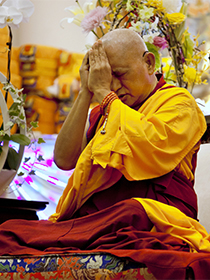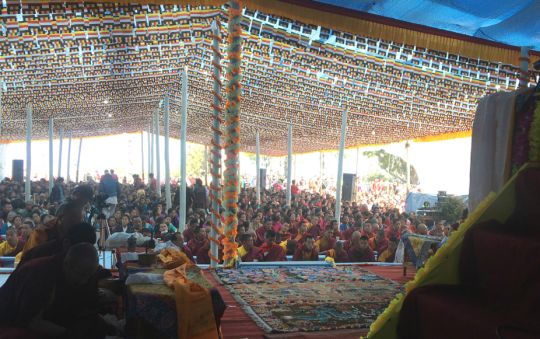- Home
- FPMT Homepage
Foundation for the Preservation of the Mahayana Tradition
The FPMT is an organization devoted to preserving and spreading Mahayana Buddhism worldwide by creating opportunities to listen, reflect, meditate, practice and actualize the unmistaken teachings of the Buddha and based on that experience spreading the Dharma to sentient beings. We provide integrated education through which people’s minds and hearts can be transformed into their highest potential for the benefit of others, inspired by an attitude of universal responsibility and service. We are committed to creating harmonious environments and helping all beings develop their full potential of infinite wisdom and compassion. Our organization is based on the Buddhist tradition of Lama Tsongkhapa of Tibet as taught to us by our founders Lama Thubten Yeshe and Lama Thubten Zopa Rinpoche.
- Willkommen
Die Stiftung zur Erhaltung der Mahayana Tradition (FPMT) ist eine Organisation, die sich weltweit für die Erhaltung und Verbreitung des Mahayana-Buddhismus einsetzt, indem sie Möglichkeiten schafft, den makellosen Lehren des Buddha zuzuhören, über sie zur reflektieren und zu meditieren und auf der Grundlage dieser Erfahrung das Dharma unter den Lebewesen zu verbreiten.
Wir bieten integrierte Schulungswege an, durch denen der Geist und das Herz der Menschen in ihr höchstes Potential verwandelt werden zum Wohl der anderen – inspiriert durch eine Haltung der universellen Verantwortung und dem Wunsch zu dienen. Wir haben uns verpflichtet, harmonische Umgebungen zu schaffen und allen Wesen zu helfen, ihr volles Potenzial unendlicher Weisheit und grenzenlosen Mitgefühls zu verwirklichen.
Unsere Organisation basiert auf der buddhistischen Tradition von Lama Tsongkhapa von Tibet, so wie sie uns von unseren Gründern Lama Thubten Yeshe und Lama Thubten Zopa Rinpoche gelehrt wird.
- Bienvenidos
La Fundación para la preservación de la tradición Mahayana (FPMT) es una organización que se dedica a preservar y difundir el budismo Mahayana en todo el mundo, creando oportunidades para escuchar, reflexionar, meditar, practicar y actualizar las enseñanzas inconfundibles de Buda y en base a esa experiencia difundir el Dharma a los seres.
Proporcionamos una educación integrada a través de la cual las mentes y los corazones de las personas se pueden transformar en su mayor potencial para el beneficio de los demás, inspirados por una actitud de responsabilidad y servicio universales. Estamos comprometidos a crear ambientes armoniosos y ayudar a todos los seres a desarrollar todo su potencial de infinita sabiduría y compasión.
Nuestra organización se basa en la tradición budista de Lama Tsongkhapa del Tíbet como nos lo enseñaron nuestros fundadores Lama Thubten Yeshe y Lama Zopa Rinpoche.
A continuación puede ver una lista de los centros y sus páginas web en su lengua preferida.
- Bienvenue
L’organisation de la FPMT a pour vocation la préservation et la diffusion du bouddhisme du mahayana dans le monde entier. Elle offre l’opportunité d’écouter, de réfléchir, de méditer, de pratiquer et de réaliser les enseignements excellents du Bouddha, pour ensuite transmettre le Dharma à tous les êtres. Nous proposons une formation intégrée grâce à laquelle le cœur et l’esprit de chacun peuvent accomplir leur potentiel le plus élevé pour le bien d’autrui, inspirés par le sens du service et une responsabilité universelle. Nous nous engageons à créer un environnement harmonieux et à aider tous les êtres à épanouir leur potentiel illimité de compassion et de sagesse. Notre organisation s’appuie sur la tradition guéloukpa de Lama Tsongkhapa du Tibet, telle qu’elle a été enseignée par nos fondateurs Lama Thoubtèn Yéshé et Lama Zopa Rinpoché.
Visitez le site de notre Editions Mahayana pour les traductions, conseils et nouvelles du Bureau international en français.
Voici une liste de centres et de leurs sites dans votre langue préférée
- Benvenuto
L’FPMT è un organizzazione il cui scopo è preservare e diffondere il Buddhismo Mahayana nel mondo, creando occasioni di ascolto, riflessione, meditazione e pratica dei perfetti insegnamenti del Buddha, al fine di attualizzare e diffondere il Dharma fra tutti gli esseri senzienti.
Offriamo un’educazione integrata, che può trasformare la mente e i cuori delle persone nel loro massimo potenziale, per il beneficio di tutti gli esseri, ispirati da un’attitudine di responsabilità universale e di servizio.
Il nostro obiettivo è quello di creare contesti armoniosi e aiutare tutti gli esseri a sviluppare in modo completo le proprie potenzialità di infinita saggezza e compassione.
La nostra organizzazione si basa sulla tradizione buddhista di Lama Tsongkhapa del Tibet, così come ci è stata insegnata dai nostri fondatori Lama Thubten Yeshe e Lama Zopa Rinpoche.
Di seguito potete trovare un elenco dei centri e dei loro siti nella lingua da voi prescelta.
- 欢迎 / 歡迎
简体中文
“护持大乘法脉基金会”( 英文简称:FPMT。全名:Foundation for the Preservation of the Mahayana Tradition) 是一个致力于护持和弘扬大乘佛法的国际佛教组织。我们提供听闻,思维,禅修,修行和实证佛陀无误教法的机会,以便让一切众生都能够享受佛法的指引和滋润。
我们全力创造和谐融洽的环境, 为人们提供解行并重的完整佛法教育,以便启发内在的环宇悲心及责任心,并开发内心所蕴藏的巨大潜能 — 无限的智慧与悲心 — 以便利益和服务一切有情。
FPMT的创办人是图腾耶喜喇嘛和喇嘛梭巴仁波切。我们所修习的是由两位上师所教导的,西藏喀巴大师的佛法传承。
繁體中文
護持大乘法脈基金會”( 英文簡稱:FPMT。全名:Found
ation for the Preservation of the Mahayana Tradition ) 是一個致力於護持和弘揚大乘佛法的國際佛教組織。我們提供聽聞, 思維,禪修,修行和實證佛陀無誤教法的機會,以便讓一切眾生都能 夠享受佛法的指引和滋潤。 我們全力創造和諧融洽的環境,
為人們提供解行並重的完整佛法教育,以便啟發內在的環宇悲心及責 任心,並開發內心所蘊藏的巨大潛能 — 無限的智慧與悲心 – – 以便利益和服務一切有情。 FPMT的創辦人是圖騰耶喜喇嘛和喇嘛梭巴仁波切。
我們所修習的是由兩位上師所教導的,西藏喀巴大師的佛法傳承。 察看道场信息:
- FPMT Homepage
- News/Media
-
- Study & Practice
-
-
- About FPMT Education Services
- Latest News
- Programs
- New to Buddhism?
- Buddhist Mind Science: Activating Your Potential
- Heart Advice for Death and Dying
- Discovering Buddhism
- Living in the Path
- Exploring Buddhism
- FPMT Basic Program
- FPMT Masters Program
- FPMT In-Depth Meditation Training
- Maitripa College
- Lotsawa Rinchen Zangpo Translator Program
- Universal Education for Compassion & Wisdom
- Online Learning Center
-
- Prayers & Practice Materials
- Overview of Prayers & Practices
- Full Catalogue of Prayers & Practice Materials
- Explore Popular Topics
- Benefiting Animals
- Chenrezig Resources
- Death & Dying Resources
- Lama Chopa (Guru Puja)
- Lama Zopa Rinpoche: Compendium of Precious Instructions
- Lama Zopa Rinpoche: Life Practice Advice
- Lama Zopa Rinpoche Practice Series
- Lamrim Resources
- Mantras
- Prayer Book Updates
- Purification Practices
- Sutras
- Thought Transformation (Lojong)
- Audio Materials
- Dharma Dates - Tibetan Calendar
- Translation Services
- Publishing Services
- Ways to Offer Support
- Prayers & Practice Materials
-
- Teachings and Advice
- Find Teachings and Advice
- Lama Zopa Rinpoche Advice Page
- Lama Zopa Rinpoche: Compendium of Precious Instructions
- Lama Zopa Rinpoche Video Teachings
- ༧སྐྱབས་རྗེ་བཟོད་པ་རིན་པོ་ཆེ་མཆོག་ནས་སྩལ་བའི་བཀའ་སློབ་བརྙན་འཕྲིན།
- Podcasts
- Lama Yeshe Wisdom Archive
- Buddhism FAQ
- Dharma for Young People
- Resources on Holy Objects
- Teachings and Advice
-
-
*If a menu item has a submenu clicking once will expand the menu clicking twice will open the page.
-
-
- Centers
-
- Teachers
-
- Projects
-
-
-
-
*If a menu item has a submenu clicking once will expand the menu clicking twice will open the page.
-
-
- FPMT
-
-
-
-
-
FPMT is unbelievably fortunate that we have many qualified teachers who are not only scholars but are living in practice. If you look, then you can understand how fortunate we are having the opportunity to study. With our Dharma knowledge and practice we can give the light of Dharma to others, in their heart. I think that’s the best service to sentient beings, the best service to the world.
Lama Zopa Rinpoche, (read the full advice from Rinpoche)
-
-
-
- Shop
-
-
-
The Foundation Store is FPMT’s online shop and features a vast selection of Buddhist study and practice materials written or recommended by our lineage gurus. These items include homestudy programs, prayers and practices in PDF or eBook format, materials for children, and other resources to support practitioners.
Items displayed in the shop are made available for Dharma practice and educational purposes, and never for the purpose of profiting from their sale. Please read FPMT Foundation Store Policy Regarding Dharma Items for more information.
-
-
Lama Zopa Rinpoche News
9
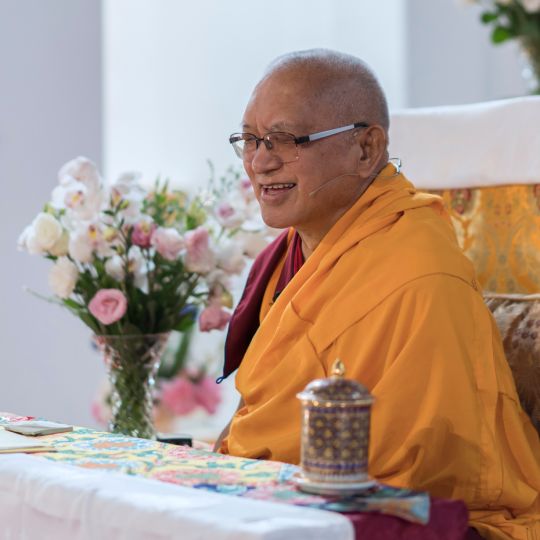
Lama Zopa Rinpoche giving a teaching at the Great Stupa of Universal Compassion, Bendigo, Australia, April 2018. Photo by Ven. Lobsang Sherab.
Lama Zopa Rinpoche gave advice about paying government tax and health insurance, instructing to see it as an opportunity to practice charity, thus a cause for happiness and full enlightenment, for oneself and others.
I spoke to the ex-Kopan monks and nuns in New York, in a restaurant run by people from Mustang. I talked to one Nepalese girl who had previously worked in Nepal for one year. She told me that after she got money from working in the United States, a lot of the money went as tax to the US government, in federal and state tax, and also for Medicare and health insurance. I gave her this advice about using every opportunity to become Dharma, especially Mahayana Dharma, so that it becomes the cause of enlightenment.
You have to pay tax to the state and federal government, as well as paying Medicare and health insurance, and then you feel resentful and become miserly, which is the cause of poverty. Also, by creating so much miserliness you become unhappy, but you have no choice because you have to give the money.
I said this is a most incredible opportunity for you to practice Dharma. By giving tax to the state and federal government you can use this as a method of giving charity and generating bodhichitta. When you have to make the payments, you can think about the purpose of paying this money.
Think, “May I myself achieve enlightenment in order to free the numberless sentient beings from the oceans of samsaric sufferings in the six realms and bring them to buddhahood—the total cessation of all the obscurations and completion of all the realizations. Therefore, I am making charity of this money.”
Thinking this way is incredible. This way, not only does it become Dharma, but it becomes the cause of oneself achieving buddhahood. It also becomes the cause of happiness for numberless sentient beings, to free them from oceans of samsaric sufferings and bring them to buddhahood—the total cessation of all the obscurations and completion of all the realizations. Therefore this becomes the cause of happiness. Wow, wow, wow, wow. Amazing, amazing, amazing. This becomes the best cause of happiness up to full enlightenment.
According to the Tengyur, Buddha said:
For any sentient being, who during the period of my teachings
Makes charity well (even if the material is the size of a hair)
For 80,000 eons will experience a great result of great enjoyment:
No pain, no disease, and enjoyment of happiness.
Like that, one will be enriched with the desirable things.
At the end you can actually achieve the result—the peerless cessation and completion (enlightenment).
After hearing that there is a great result, who wouldn’t want to collect merit?
Wow, wow, wow, wow, wow!
Here it mentions in the quotation that by making charity of something just the size of one single hair, you receive benefits for 80,000 eons. You will have unbelievable happiness and wealth, most unbelievable happiness, and also by continually making charity, at the end you will achieve enlightenment. Here the charity that you make is much more than money. It is unbelievable, unbelievable, unbelievable, so you can rejoice, you can feel very happy. It’s unbelievable, unbelievable, unbelievable.
It’s the same when you pay the health insurance and Medicare, because even though you are not sick all the time, there are many other sick people, who have cancer or incurable or curable diseases. The money goes for that, so again you are making charity. Wow, wow, wow, wow! So you should rejoice.
It’s unbelievable, it’s like the person who wins the soccer game—they are running around, all the nerves out, their shoulders up. In reality that is all done with attachment, so it’s the cause of the lower realms, but expressing happiness here, this is for enlightenment—full enlightenment for oneself and then to free the numberless sentient beings from the oceans of samsaric suffering and bring them to full enlightenment. Wow, wow, wow, wow!
It is very important to think this way, to use the situation of paying tax and so forth as a way to create the cause of enlightenment.
This advice, “Motivation for Paying Tax,” is from “Lama Zopa Rinpoche’s Online Advice Book,” published in January 2018 on the Lama Yeshe Wisdom Archive website:
https://www.lamayeshe.com/advice/motivation-paying-tax
Watch Lama Zopa Rinpoche teach during the Heart of Wisdom Retreat at the Great Stupa of Universal Compassion in Bendigo, Australia, March 30-May 12, 2018!
- Find links to watch teachings LIVE:
https://fpmt.org/media/streaming/lama-zopa-rinpoche-live/ - Watch, read, and listen to all of Rinpoche’s teachings from Bendigo at anytime:
https://fpmt.org/media/streaming/teachings-of-lama- zopa-rinpoche/
Lama Zopa Rinpoche is the spiritual director of the Foundation for the Preservation of Mahayana Tradition (FPMT), a Tibetan Buddhist organization dedicated to the transmission of the Mahayana Buddhist tradition and values worldwide through teaching, meditation, and community service.
- Tagged: lama zopa rinpoche, taxes
6
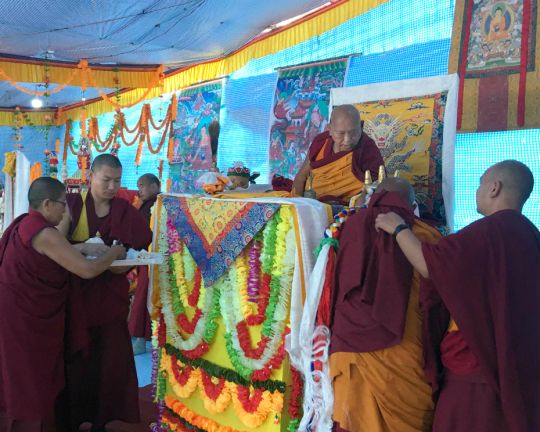
Lama Zopa Rinpoche receiving mandala offering, Taplejung, Nepal, March 2018. Photo courtesy of Ven. Thubten Jikdol.
In early March, Lama Zopa Rinpoche flew by helicopter to Taplejung Municipality in the Taplejung District in northeastern Nepal to attended a large event for world peace organized by the local community. Ven. Thubten Jikdol, a senior monk at Kopan Monastery, arranged for Lama Zopa Rinpoche to be a guest of honor at the event and shared this report.
Lama Zopa Rinpoche recently visited Taplejung for the second Vajra Guru Mantra Recitation Puja Ceremony for World Peace, organized by the Taplejung Vajra Guru Organizing Committee, March 4-6, 2018.
The World Peace puja attracted high lamas, approximately 250 ordained Sangha, and more than 5,000 lay students. During the three-day event, seven million Guru Rinpoche (Padmasambhava) mantras were recited.
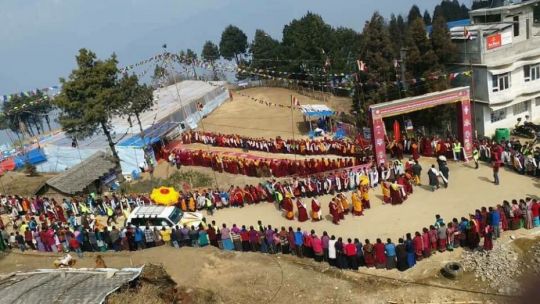
Lama Zopa Rinpoche arriving at the puja venue, Taplejung, Nepal, March 2018. Photo courtesy of Ven. Thubten Jikdol.
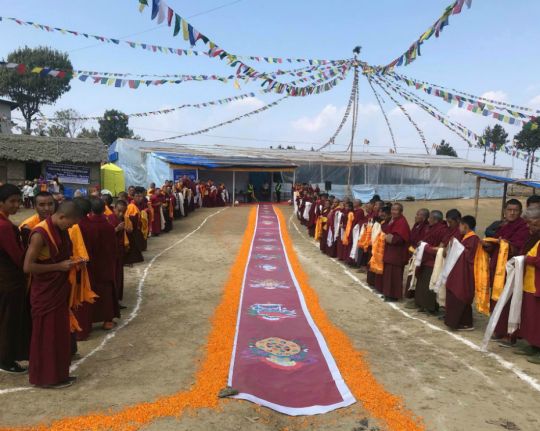
Sangha waiting to welcome Lama Zopa Rinpoche to the puja venue, Taplejung, Nepal, March 2018. Photo courtesy of Ven. Thubten Jikdol.
On March 5, Lama Zopa Rinpoche was warmly welcomed by a thousand people in a procession from Suketar Airport to the puja venue. As soon as Rinpoche arrived, the organizing committee made mandala offerings and a welcoming song and dance were offered by Sangag Dhechoe Ling Gompa School students.
Rinpoche gave a short teaching and also granted Mani mantra and Guru Rinpoche mantra oral transmissions.
After the teaching and oral transmission, Rinpoche visited Tashi Choeling Monastery and made a butter lamp offering and consecration blessing at a newly constructed stupa. Rinpoche also visited Sangag Dechoe Ling Monastery at Bungkulung.
On March 6, Lama Zopa Rinpoche gave a teaching and a White Tara long life initiation. A relic of the Buddha, received from the Dharmakaya Foundation, Thailand to Nepal Buddhist Federation, was exhibited to all.
The books Dear Lama Zopa and How to Be Happy by Lama Zopa Rinpoche, and Make Your Mind an Ocean by Lama Yeshe—all having been translated into Nepali—were distributed for free to people at the event.
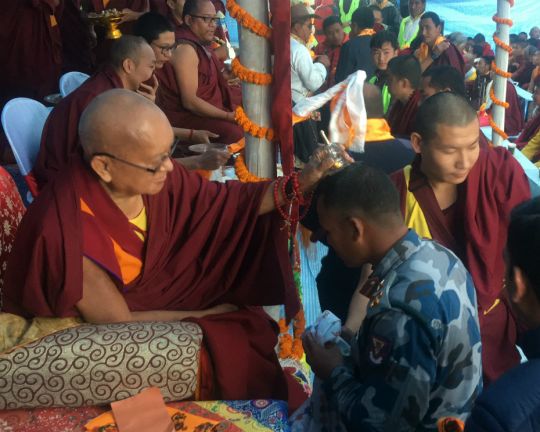
Lama Zopa Rinpoche giving blessing, Taplejung, Nepal, March 2018. Photo courtesy of Ven. Thubten Jikdol.
On March 7, before returning to Kathmandu, Lama Zopa Rinpoche made a short visit to a Hindu shrine at Pathibara Hill to pray for all the animals that are sacrificed at Pathibara Temple.
Rinpoche also kindly visited and blessed a new construction site on Sangag Dhechoe Ling Gompa School land. This school is very important for the area people. Most of the population of this region is Buddhist, but due to a lack of local Buddhist teachers and knowledge, people aren’t able to receive correct instruction to understand and practice authentic Buddhist teachings.
This ongoing decline is happening as a result of changes made in the name of modernization. The main objective of organizing such a school in this region is to preserve and promote Buddhadharma and the culture of the local people for the benefit of all mankind and world peace.
Watch Rinpoche teach from Bendigo, Australia, during the retreat at the Great Stupa of Universal Compassion, March 30-May 12. For details on the livestream:
https://fpmt.org/media/streaming/lama-zopa-rinpoche-live/
More information, photos and updates about FPMT spiritual director Lama Zopa Rinpoche can be found on Rinpoche’s webpage on FPMT.org. If you’d like to receive news of Lama Zopa Rinpoche and FPMT via email, sign up to FPMT News.
- Tagged: lama zopa rinpoche, nepal, taplejung
2
Rejoice That We Didn’t Die
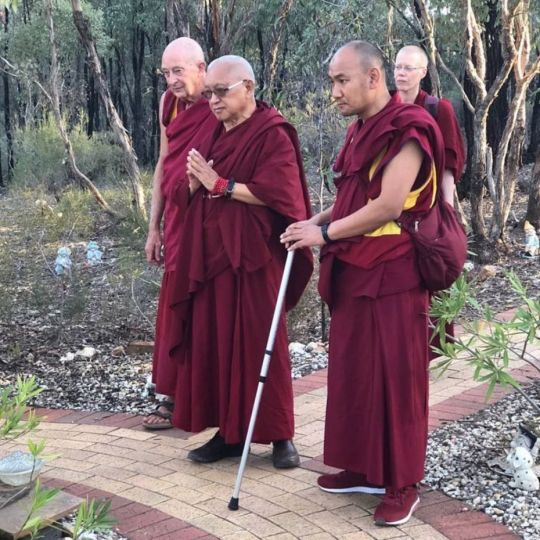
Lama Zopa Rinpoche on the path to the Great Stupa of Universal Compassion in Bendigo, Australia, where Rinpoche is leading a six-week retreat, April 2018. Photo via Lama Zopa Rinpoche on Instagram.
“Somebody who doesn’t know what to do—many [people] have practices in the life, commitments and many practices, but somebody who has no clear idea of what to practice; if they want to do some practice in the daily life but don’t know what to practice, what to do, my suggestion is that, something very simple,” Rinpoche advices in a teaching published in the Lama Yeshe Wisdom Archive September 2017 E-Letter.
“So first thing in the morning rejoice that so far we didn’t die, that we didn’t die, rejoice. Then after that, by remembering all those people who died, family members, then if there are gurus who passed away, remember those and family members who have passed away, friends who have died. Anyway, rejoice that we did not die so far. And again today we are able to be a human being, and not only that but we have a perfect human rebirth, so that we can achieve the three great meanings, more precious than the whole sky filled with the wish-granting jewels. All those are nothing compared with our precious human body, with which we can achieve three great meanings in every second, whatever we wish for. Even in every minute, we can achieve all that, because we can create the cause.
“So rejoice, then think death can happen any minute. Death can happen any [time], death can happen even today, any minute it can happen, any moment death can happen. Either make complete determination, thinking that we are going to die today, that’s the best, however, think it can happen any day, even today, in any minute it can happen. Then make strong determination of what we should do with our life. Then on the basis of correctly devoting to the virtuous friend, that’s how to practice Dharma. The most profitable way to practice Dharma is correctly devoting to the virtuous friend. That’s how to make our practice most successful.” …
Read the entire teaching “You Have Time to Get It Done” from teachings given at Tara Institute in Melbourne, Australia, in March 2000 and published in Lama Yeshe Wisdom Archive September 2017 E-Letter:
https://www.lamayeshe.com/article/e-letter-no-171-september-2017
Watch Rinpoche teach from Bendigo, Australia, during the retreat at the Great Stupa of Universal Compassion, March 30-May 12. For details on the livestream:
https://fpmt.org/media/streaming/lama-zopa-rinpoche-live/
More information, photos and updates about FPMT spiritual director Lama Zopa Rinpoche can be found on Rinpoche’s webpage on FPMT.org. If you’d like to receive news of Lama Zopa Rinpoche and FPMT via email, sign up to FPMT News.
- Tagged: death, lama yeshe wisdom archive, lama zopa rinpoche, rejoice
30
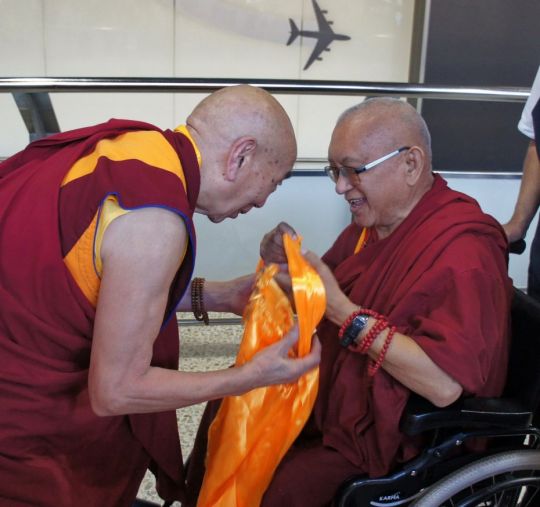
Geshe Lobsang Doga greeting Lama Zopa Rinpoche at the airport in Melbourne, Australia, March 2018. Photo courtesy of Tara Institute’s Facebook page.
Lama Zopa Rinpoche arrived in Australia, where he’ll be teaching through early June. Rinpoche was greeted at the airport in Melbourne by Geshe Lobsang Doga, resident geshe of Tara Institute, and Tara Institute students.
Then Rinpoche was driven two hours to Bendigo, Australia, home of the Great Stupa of Universal Compassion to lead a six-week retreat. Rinpoche is teaching on Shantideva’s A Guide to the Bodhisattva’s Way of Life (Bodhicaryavatara), with the optional tantric empowerments of Chakrasamvara and Rinjung Gyatsa.
Rinpoche’s teachings during the retreat are being livestreamed. For details, see:
https://fpmt.org/media/streaming/lama-zopa-rinpoche-live/
The retreat runs March 30-May 12. Many people have been working to get the Great Stupa ready for the retreat. A very large thangka of the Twenty-One Taras is hanging in the gompa inside the Great Stupa. This retreat is the third in a series of retreats given by Rinpoche in this location.
“This retreat came about because the late Khunu Lama Rinpoche requested Lama Zopa Rinpoche to translate Shantideva’s Bodhicaryavatara (A Guide to the Bodhisattva’s Way of Life),” explained Ven. Roger Kunsang, Rinpoche’s assistant and CEO of FPMT.
“Khunu Lama Rinpoche made this request after he gave Lama Zopa Rinpoche the commentary on the Bodhicaryavatara at Lama Zopa Rinpoche’s request. So Lama Zopa Rinpoche is teaching the Bodhicaryavatara at the same time as translating it. (A small team led by Ven. Ailsa Cameron is carefully noting Rinpoche’s translation as he teaches.)
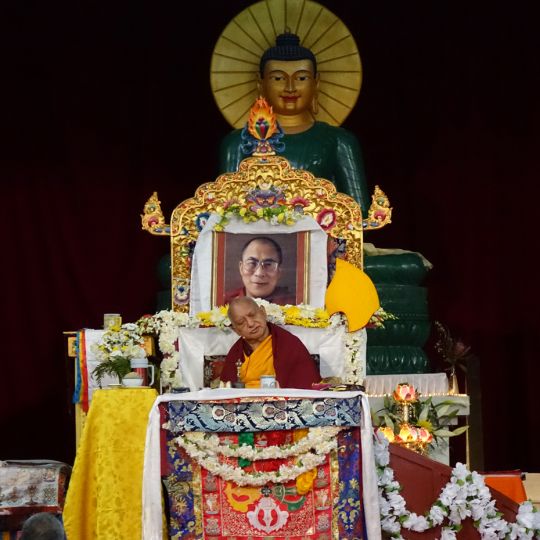
Lama Zopa Rinpoche teaching at the Great Stupa of Universal Compassion, Bendigo, Australia, October 2014. Photo by Ven. Roger Kunsang.
“Then Lama Zopa Rinpoche was requested by Ven. Gyatso (director of Thubten Shedrup Ling Monastery in Bendigo) to give the Rinjung Gyatsa set of initiations, which is quite rare. Rinpoche commented that it is common in the Tibetan Buddhist tradition to organize initiations into ‘sets.’ Also that different deities have different purposes and benefits, and that once you receive the permission to practice that deity, you have more potential to help others and are also helping to preserve Buddhism.
“Lama Zopa Rinpoche has combined both into one retreat. The first installment of this retreat was in April 2011 and the second installment took place in September-October 2014.”
Read about the April 2011 retreat in the Mandala story “The Retreat of a Life Time.” The September-October 2014 retreat was covered in many FPMT news blog posts, which include links to video from Rinpoche’s teachings there. You can also access video recordings of Rinpoche’s teachings from the Australia 2014 retreat on FPMT’s Rinpoche Available Now page (fpmt.org/rinpochenow/).
Watch Rinpoche teach from Bendigo, Australia, during the retreat at the Great Stupa of Universal Compassion, March 30-May 12. For details on the livestream:
https://fpmt.org/media/streaming/lama-zopa-rinpoche-live/
Lama Zopa Rinpoche is the spiritual director of the Foundation for the Preservation of Mahayana Tradition (FPMT), a Tibetan Buddhist organization dedicated to the transmission of the Mahayana Buddhist tradition and values worldwide through teaching, meditation, and community service.
- Tagged: australia, australia retreat 2018, bendigo, fpmta, great stupa of universal compassion, lama zopa rinpoche
26
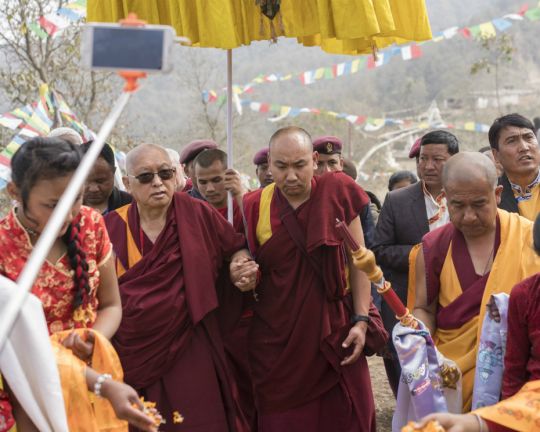
Lama Zopa Rinpoche, welcomed by local people, going to bless the stupa built by Losang Namgyal Rinpoche, who is leading Rinpoche, in Pakarbas, Nepal, February 2018. Photo by Ven. Lobsang Sherab.
On February 25, Lama Zopa Rinpoche and Losang Namgyal Rinpoche, the head lama of Nepal’s Tamang people, consecrated a newly built 45-foot (14-meter) tall Enlightenment Stupa in Pakarbas, Ramechhap, Nepal. The stupa was built by Losang Namgyal Rinpoche and the local people and sponsored by Lama Zopa Rinpoche. Monks from Kopan’s lower tantric college also participated in the stupa consecration. Rinpoche was enthusiastically welcomed to the event, which was well attended by high officials and villagers.
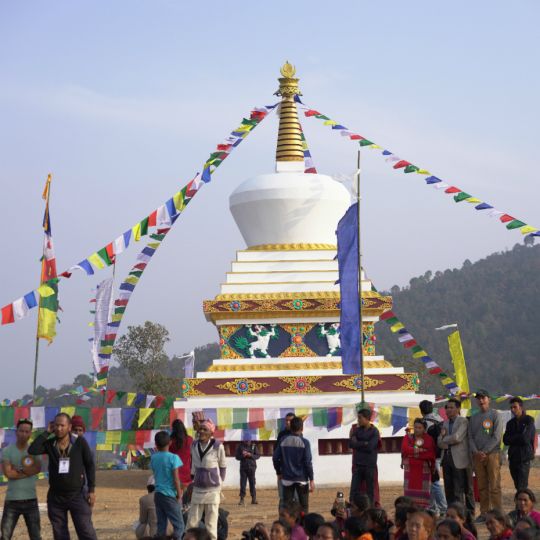
45-foot-tall Enlightenment Stupa built by Losang Namgyal Rinpoche and local community, Pakarbas, Ramechhap, Nepal, February 2018. Photo by Ven. Lobsang Sherab.
Rinpoche then traveled to Pokhara, Nepal’s second largest city and the site of many lakes. Rinpoche spent a few of the 15 Days of Miracles in Pokhara, where he devoted a lot of time to blessing food and water for the fish and living beings in the lakes. Rinpoche went out on a boat on Begnas Lake, Pokhara’s second largest lake, and offered the food and water with prayers and mantras.
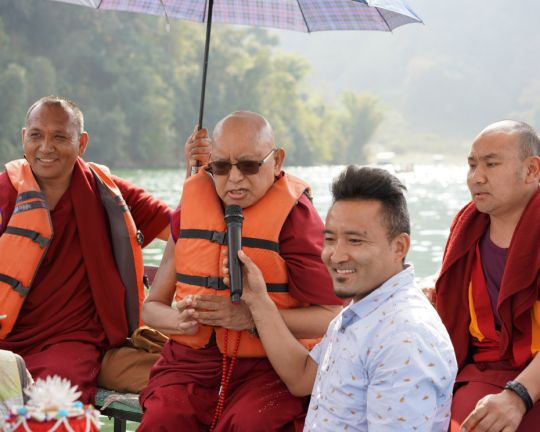
Lama Zopa Rinpoche blessing the fish and all beings in the lake with mantras and prayers, Pokhara, Nepal, March 2018. Photo by Ven. Lobsang Sherab.
Wherever Rinpoche goes, he makes an effort to prioritize this kind of charity.
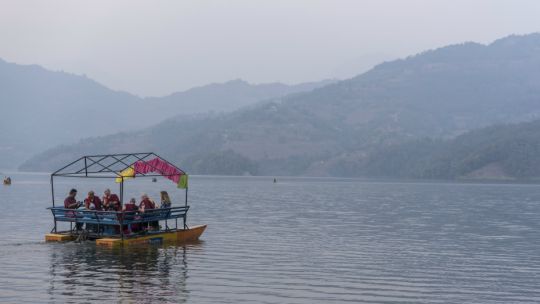
Lama Zopa Rinpoche blessing the fish in the lake, Pokhara, Nepal, March 2018. Photo by Ven. Lobsang Sherab.
Rinpoche also visited the Jampaling Tibetan settlement near Pokhara, where Rinpoche saw a Maitreya statue that speaks and other holy objects, many brought from Tibet.
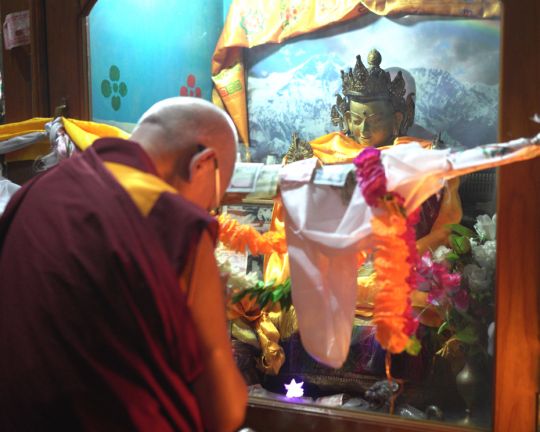
Rinpoche making prayers in front of the Maitreya statue that speaks at Jampaling Tibetan settlement, Nepal, February 2018. Photo by Ven. Lobsang Sherab.
Rinpoche next traveled by helicopter to a village in Taplejung district in mountainous northeastern Nepal. Rinpoche gave a White Tara initiation attended by approximately 5,000 people, some traveling for two days on foot to get there.
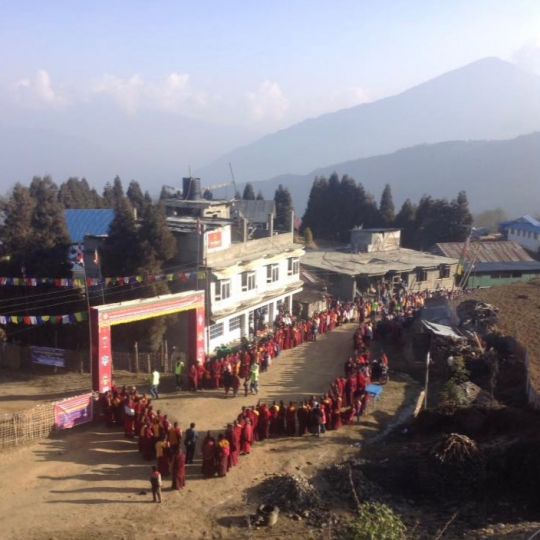
Local Sangha and villagers line up to welcome Lama Zopa Rinpoche, Solu Khumbu, Nepal, March 2018. Photo by Pema Tengya via Facebook.
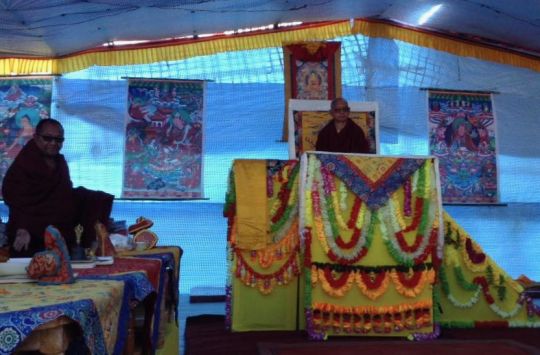
Lama Zopa Rinpoche during White Tara initiation, Solu Khumbu, Nepal, March 2018. Photo by Pema Tengya via Facebook.
This event and the stupa consecration were both quite special as Rinpoche does not often lead ceremonies for local people in the rural areas of Nepal.
After returning briefly to Kopan, Rinpoche traveled to Tushita Mahayana Meditation Centre in Delhi, India.
See the new photo album from Lama Zopa Rinpoche’s February-March visit to Nepal:
https://fpmt.org/teachers/zopa/gallery/nepal-february-march-2018/
Watch Rinpoche teach from Bendigo, Australia, during the retreat at the Great Stupa of Universal Compassion, March 30-May 12. For details on the livestream:
https://fpmt.org/media/streaming/lama-zopa-rinpoche-live/
Lama Zopa Rinpoche is the spiritual director of the Foundation for the Preservation of the Mahayana Tradition (FPMT), a Tibetan Buddhist organization dedicated to the transmission of the Mahayana Buddhist tradition and values worldwide through teaching, meditation and community service.
- Tagged: lama zopa rinpoche, losang namgyal rinpoche, nepal, pokhara, taplejung
12
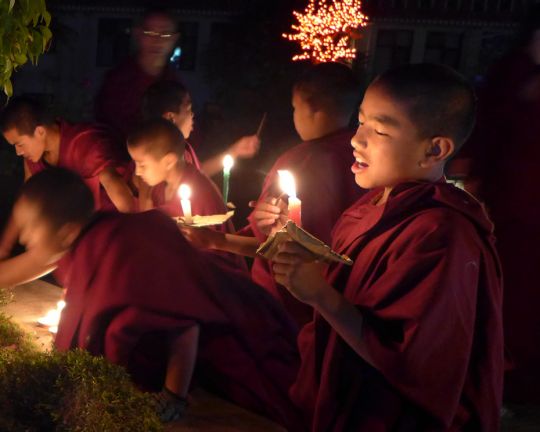
Young monk chanting Migtsema while making a light offering on Lama Tsongkhapa Day, Kopan Monastery, Nepal, December 2016. Photo by Laura Miller.
Every year the Sangha at Kopan Monastery celebrate Lama Tsongkhapa Day with incredible light offerings, including hundreds of thousands of strung lights encircling the buildings at the monastery and nunnery, and a special evening offering of candles.
The holy day commemorates the anniversary of the parinirvana of Lama Je Tsongkhapa (1357-1419), the founder of the Gelug tradition of Tibetan Buddhism.
Lama Zopa Rinpoche was at Kopan during this past year’s Lama Tsongkhapa Day, which was on December 12, 2017.
A new, short video shares scenes and sounds from 2017’s joyous celebration. Watch Rinpoche and Kopan’s monks make light offerings, chant Migtsema (a short prayer to Lama Tsongkhapa), and circumambulate Kopan’s main gompa and large stupas.
Watch Kopan Monastery Lama Tsongkhapa Day on YouTube:
https://youtu.be/MQ1XOKnQX1s
Find more short videos of Lama Zopa Rinpoche teaching and visiting FMPT centers, projects, and services around the world:
https://fpmt.org/media/streaming/videos-of-lama-zopa-rinpoche/
Learn more about Kopan Monastery:
http://kopanmonastery.com/
Lama Zopa Rinpoche is the spiritual director of the Foundation for the Preservation of Mahayana Tradition (FPMT), a Tibetan Buddhist organization dedicated to the transmission of the Mahayana Buddhist tradition and values worldwide through teaching, meditation, and community service.
- Tagged: kopan monastery, lama tsongkhapa day, lama zopa rinpoche, lama zopa rinpoche video short, video, video short
9
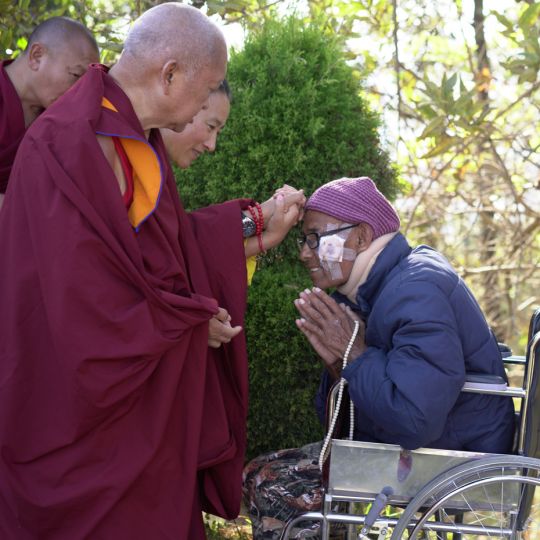
Lama Zopa Rinpoche and Khadro-la (Rangjung Neljorma Khandro Namsel Drönme) making prayers for and blessing Kamal, who worked for many years at Kopan Monastery in the dining room and kitchen and who died in early March, Kopan Monastery, Nepal, February 2018. Photo by Ven. Lobsang Sherab.
Lama Zopa Rinpoche offered advice to a student who was injured by a fall and who had not healed and was worried. Here’s what Rinpoche told the student:
Think that, “I am the most fortunate one, that I have this sickness. I am the most fortunate one. Why? Because by having this sickness now I can practice pure Dharma. I have been given the opportunity to practice pure Dharma. I can experience all sentient beings’ pain, disease, spirit harm, negative karma, and obscurations, and they can all achieve the dharmakaya.”
Also you can meditate that you receive all sentient beings’ pain, disease, negative karma and obscurations. Think that you have received these in your heart in the form of darkness, like smoke or like black fog, and they destroy the self-cherishing thought, where all the sufferings come from. They are brought into the heart and received there, like throwing an atomic bomb on the enemy, so self-cherishing thoughts are totally smashed.
Here you give this to the self-cherishing thought that has caused you beginningless oceans of samsara in the six realms up to the present, as well as the present and endless future oceans of suffering—not only your own suffering but it has also given suffering to numberless sentient beings from beginningless lives up to now—and as long as you don’t generate bodhichitta, it will bring endless suffering to numberless sentient beings again. So destroy the one enemy, this self-cherishing thought. Think it is totally destroyed, and think that all sentient beings receive dharmakaya.
You can do tonglen, if you can, taking on others’ suffering and with loving kindness and compassion giving your body, possessions and merits to other sentient beings, so they all receive enlightenment, they achieve rupakaya.
[If you can, listen online to the teachings that Rinpoche recently gave at the Light of the Path retreat in North Carolina. If you can watch that or listen to that, it would be very good.]Much of your day you can recite the following, just as you would recite a mantra such as OM MANI PADME HUM. Instead, recite the following like a mantra. If you can, do at least four malas a day of this:
By my having to experience this sickness, may all sentient beings be free immediately from all the diseases, spirit harm, negative karma, and defilements.
Pray like this and recite four malas of this each day. This prayer is from the great yogi Choje Götsangpa.
You can see this sickness is helping you, and that is why I said how fortunate you are. You can collect more than skies of merit and purify negative karma and defilements collected from beginningless rebirth. This brings you to enlightenment quickly. This is why I said at the beginning how fortunate you are to think in this way, to recognize this.
It is very, very, very good. In reality it is like this. This is a gain, it’s not a loss for you; it is the highest gain, so please do this.
With much love and prayers …
From the advice “How Fortunate You Are to Have This Sickness,” given in November 2016 by Lama Zopa Rinpoche and published in January 2018 by Lama Yeshe Wisdom Archive on “Lama Zopa Rinpoche’s Online Advice Book”:
https://www.lamayeshe.com/advice/how-fortunate-you-are-have-sickness
More information, photos, and updates about FPMT spiritual director Lama Zopa Rinpoche can be found on Rinpoche’s webpage on FPMT.org. If you’d like to receive news of Lama Zopa Rinpoche and FPMT via email, sign up to FPMT News.
- Tagged: hardships, lama zopa rinpoche, lojong, mind training, sickness
5

Lama Zopa Rinpoche sitting outside the cafe at Kopan Monastery, Nepal, February 2018. Photo by Ven. Lobsang Sherab.
Lama Zopa Rinpoche was at Kopan Monastery during February, between travels, and met with a number of people, including Khadro-la (Rangjung Neljorma Khandro Namsel Drönme) and a group of Chinese Sangha from Wutaishan. He gave an oral transmission to them in his room.
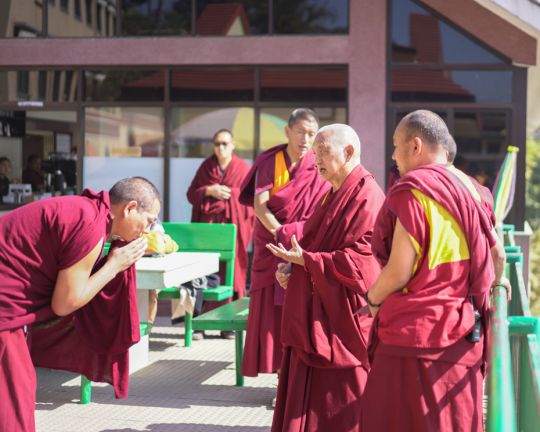
Rinpoche talking with Kopan monks outside the cafe, Kopan Monastery, Nepal, February 2018. Photo by Ven. Lobsang Sherab.
After a magnitude 6.4 earthquake with many strong aftershocks affected Hualien, Taiwan, in early February, Rinpoche requested Sangha to recite the Vajra Cutter Sutra and do prayers for Taiwan and those impacted by the earthquake.

Lama Zopa Rinpoche during Palden Lhamo puja early on the morning of Losar, Kopan Monastery, Nepal, February 2018. Photo by Ven. Lobsang Sherab.

On Losar, Kopan nuns taking a pinch of chemar, part of the New Year’s celebration, Kopan Monastery, Nepal, February 2018. Photo by Ven. Lobsang Sherab.
On the first day of Losar, Rinpoche joined with Kopan Sangha for Palden Lhamo puja in the early morning and then did Guru Puja.
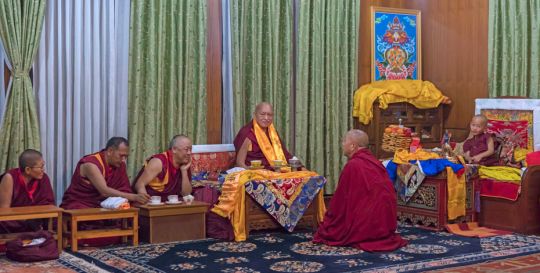
Rinpoche with Ven. Pemba Sherpa, Ven. Jangsem, and Ven. Shenphen meeting the reincarnation of Trulshik Rinpoche, Tenzin Choekyi Lodoe Rinpoche, at Sitapaila on the fourth day of Losar, Nepal, February 2018. Photo by Ven. Lobsang Sherab.
Rinpoche went and visited the reincarnation of Trulshik Rinpoche on the fourth day of Losar.
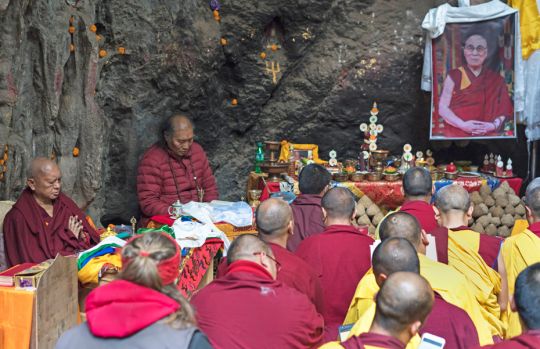
Rinpoche with Oser Dorje Rinpoche, Kopan Monastery lower tantric college monks, and others doing prayers at Maratika Cave, Nepal, February 2018. Photo by Ven. Lobsang Sherab.
Then Rinpoche traveled to Maratika Cave, the sacred cave associated with Padmasambhava (Guru Rinpoche) and longevity. While there Rinpoche, joined monks from Kopan and others, doing prayers and practices. Kopan’s lower tantric college monks were at Maratika reciting the Amitayus Long Life Sutra and the Guhyasamaja root text every day for Rinpoche’s long life.
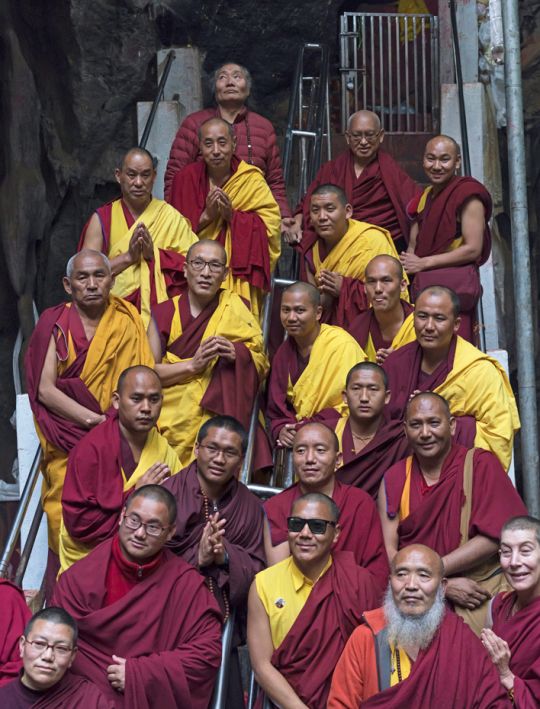
Group photo of Lama Zopa Rinpoche and Oser Dorje Rinpoche with Kopan Monastery lower tantric college monks and others at Maratika Cave, Nepal, February 2018. Photo by Ven. Lobsang Sherab.
Lama Zopa Rinpoche is the spiritual director of the Foundation for the Preservation of Mahayana Tradition (FPMT), a Tibetan Buddhist organization dedicated to the transmission of the Mahayana Buddhist tradition and values worldwide through teaching, meditation, and community service.
- Tagged: kopan monastery, lama zopa rinpoche, losar, maratika cave
2
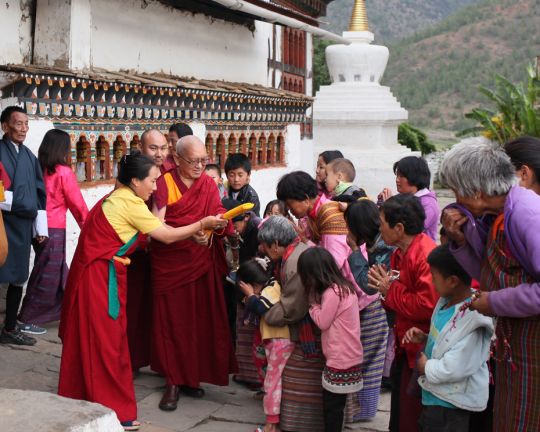
Lama Zopa Rinpoche and Khadro-la blessing people with a Dharma text, Bhutan, May 2016. Photo by Ven. Lobsang Sherab.
“My iPad contains the Kangyur, the Tengyur, many teachings. It is the same as a Dharma text. You can’t put it on the bed or down [low]. You have to respect it and put it higher,” Rinpoche explained in a short teaching on how to show proper respect for Dharma texts, including when they are in electronic form, during a session at the 2017 Light of the Path retreat.
“You can’t put glasses or malas on top of Dharma texts. You have to respect them, treat them as Dharma, the holy body, revealing the path to liberate you from samsara and to achieve enlightenment. You have to respect them as Rare Sublime Dharma,” Rinpoche advises in a short video clip of the teaching.
Rinpoche emphasizes this point by talking about how Choden Rinpoche said that even one’s hand should go around, and not over, a Dharma text. Also objects such as a tea mug should not pass above a Dharma texts as it shows disrespect to the Rare Sublime Dharma.
Referring to the refuge part of lamrim teachings, Rinpoche stressed that it is very important to know the instructions on what is to be avoided and what to practice. If you are disrespecting Dharma texts, Rinpoche warns that it “pollutes the mind and obscures the mind. So by respecting [Dharma texts], then you create much good karma.”
Watch the teaching in this video clip “Proper Respect for Dharma Texts”:
https://youtu.be/aqUtQYAzKf4
Quoted text based on the unedited transcript for the 2017 Light for the Path retreat, which you can find here with video recordings of the complete teachings:
https://fpmt.org/media/streaming/teachings-of-lama-zopa-rinpoche/light-of-the-path-teachings-2017/
Find more video clips from Lama Zopa Rinpoche:
https://www.youtube.com/playlist?list=PL5F6A5E3C2873F2EA
Lama Zopa Rinpoche is the spiritual director of the Foundation for the Preservation of Mahayana Tradition (FPMT), a Tibetan Buddhist organization dedicated to the transmission of the Mahayana Buddhist tradition and values worldwide through teaching, meditation, and community service.
26
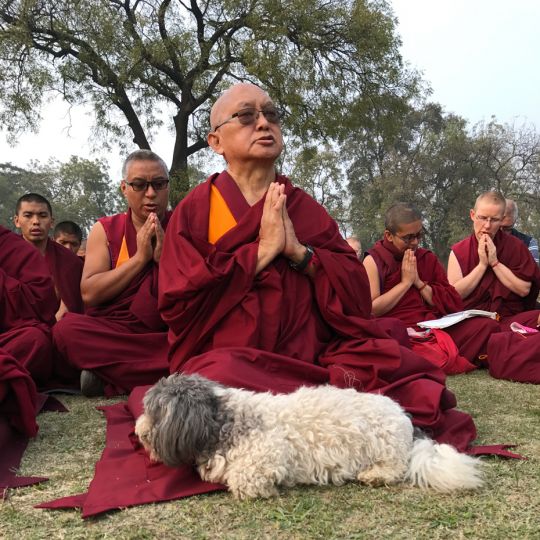
Lama Zopa Rinpoche during a visit to the stupa at Sarnath, India, January 2017. Photo by Ven. Roger Kunsang.
By generating a bodhichitta motivation throughout each day, we can benefit ourselves and sentient beings, Lama Zopa Rinpoche explained while teaching at the 100 Million Mani Mantra Retreat in Italy.
Rinpoche’s advice, captured in a video clip from the October 10, 2017, teaching, emphasizes that by having a bodhichitta motivation in any number of activities, you are able to generate heaps of merit and become profoundly beneficial.
Making Offerings
“Of course if you have an actual realization of bodhichitta, there is no question of merit,” Rinpoche says. “But even if you have an effortful motivation of bodhichitta, when you offer light—one light, even one Christmas light, whatever light, a butter lamp, one candle—you collect merits more than the sky. Wow, wow, wow!”
Circumambulating Holy Objects
Rinpoche says, “If you generate a bodhichitta motivation when you circumambulate, with each step going around circumambulating, you collect merits more than the sky.”
Eating and Drinking
“When you eat food, with each bite or drink, if it is done with a motivation of bodhichitta, then you are eating food for sentient beings, to serve sentient beings, to bring them to enlightenment,” Rinpoche says.
“And then also to make offering, make yourself in oneness with the guru-deity Chenrezig. Visualize Chenrezig in your heart, same as the guru. So with each bite, with each drink, you collect more than skies of merit. You collect with each spoonful, with each sip, merits more than the sky.”
Speaking
“If you generate the motivation of bodhichitta for when you talk, whether you are consulting, whether you are teaching Dharma, if you generate the motivation of bodhichitta, not even the realization, but effortful bodhichitta, then with each word you collect merits more than sky,” Rinpoche advises.
Walking
Rinpoche adds, “The same thing as circumambulation, when you are going for a walk, going shopping, going for pilgrimage, whatever, if it is done with a bodhichitta motivation, then with each step you collect more than skies of merits.”
The Best Motivation Is Bodhichitta
“As the Buddha said, to work for yourself and others, numberless sentient beings, the best motivation is bodhichitta. So all the buddhas, they checked, they see, it is like that,” Rinpoche says.
“Even if you don’t have a realization of bodhichitta, but you generate a bodhichitta motivation, for any activity you do—in every minute, in every second—you collect merits more than the sky! There is no time for depression. There is no space for depression. Depression, goodbye!”
Your Main Refuge Is Bodhichitta
If you pay attention to having a bodhichitta motivation throughout your life, your whole day, and with every activity, then it is your main practice and your main refuge.
Rinpoche explains, “When your life is so busy, your main refuge is bodhichitta. So every hour—not only every day, every hour, every minute, every second—is bodhichitta.” By doing this, you create so much merit, “more than the sky! Amazing, amazing!”
“By generating the motivation of bodhichitta, then when you do prayers all day long or for one hour, with each word you collect more than skies of merit. Can you imagine?” Rinpoche asks.
“You have to realize how you are most unbelievably fortunate! You are so fortunate. You are so fortunate this time. Next, next life not sure, but this life ….”
Rinpoche concludes, “With a bodhichitta motivation, whatever you are doing, working for the center, working for the company or the family, with bodhichitta, the merits you create, wow, wow, wow!”
To see Rinpoche giving this teaching, watch the video “Practicing Dharma Skillfully with Bodhichitta: https://www.youtube.com/watch?v=aTcHrkEP8I8
The quotes from Rinpoche have been lightly edited and are based on the unedited transcript of the 100 Million Mani Mantra retreat in Italy, which you can find here with video recordings of the complete teachings:
https://fpmt.org/media/streaming/teachings-of-lama-zopa-rinpoche/100-million-mani-mantra-retreat-2017/
Find more video clips from Lama Zopa Rinpoche:
https://www.youtube.com/playlist?list=PL5F6A5E3C2873F2EA
Lama Zopa Rinpoche is the spiritual director of the Foundation for the Preservation of Mahayana Tradition (FPMT), a Tibetan Buddhist organization dedicated to the transmission of the Mahayana Buddhist tradition and values worldwide through teaching, meditation, and community service.
- Tagged: bodhichitta, essential extract, lama zopa rinpoche, video
23

Lama Zopa Rinpoche and Khadro-la at Kopan Monastery, Nepal, February 2018. Photo by Ven. Lobsang Sherab.
Lama Zopa Rinpoche arrived at Kopan Monastery in early February after spending two weeks at Tso Pema in India. Khadro-la (Rangjung Neljorma Khandro Namsel Drönme) visited Rinpoche at Kopan after he returned to the monastery.
Khadro-la joined Rinpoche for lunch. They then walked around the monastery, where they met Kamal, a long-time worker at Kopan who now has cancer. Khadro-la and Rinpoche did prayers with Kamal and blessed him.
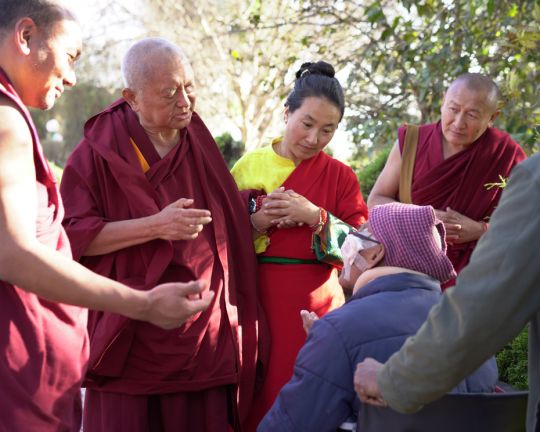
Rinpoche and Khadro-la meeting with Kamal, a long-time worker at Kopan who has cancer, Kopan Monastery, Nepal, February 2018. Photo by Ven. Lobsang Sherab.
On a tsog day, Khadro-la went with Rinpoche to Khachoe Ghakyil Ling, the Kopan nunnery, and did Vajrayogini self-initiation with the nuns. And on another day, Khadro-la and Rinpoche had lunch and then went to circumambulate the the base of Swayambhunath hill.

Lama Zopa Rinpoche celebrating the second day of Losar, giving a White Tara long life initiation, Kopan Monastery, Nepal, February 2018. Photo courtesy of Kopan Monastery’s Facebook page.
In mid-February, Rinpoche celebrated Losar, the Tibetan New Year, at Kopan.
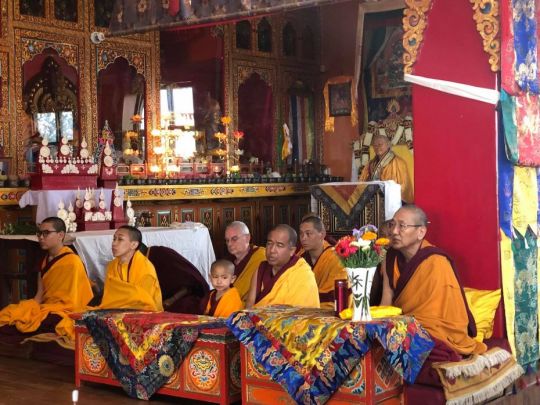
Phuntsok Rinpoche, Charok Lama, Rigsel Rinpoche, Losang Namgyal Rinpoche, and Khen Rinpoche Geshe Chonyi on the second day of Losar at Kopan Monastery, Nepal, February 2018. Photo courtesy of Kopan Monastery’s Facebook page.
Khen Rinpoche Geshe Chonyi, Kopan’s current abbot; Tenzin Phuntsok Rinpoche, the reincarnation of Geshe Lama Konchog; Thubten Rigsel Rinpoche, the reincarnation of Khensur Rinpoche Lama Lhundrup, Kopan’s former abbot; Losang Namgyal Rinpoche, a high lama of the Tamang people; Charok Lama; and many other young lamas were also in attendance at Kopan’s Losar activities, which included pujas and a White Tara long life initiation given by Lama Zopa Rinpoche.
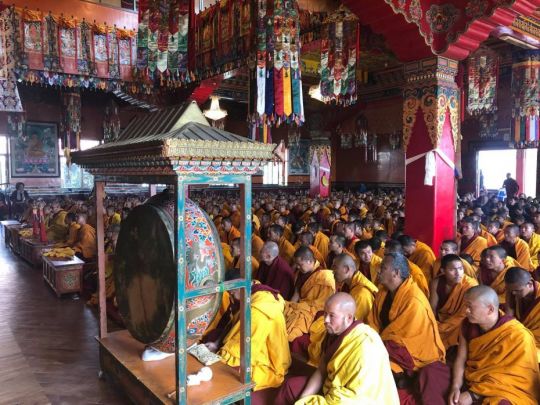
Kopan monks attending a White Tara long life initiation given by Lama Zopa Rinpoche on the second day of Losar, Kopan Monastery, Nepal, February 2018. Photo courtesy of Kopan Monastery’s Facebook page.
Lama Zopa Rinpoche is the spiritual director of the Foundation for the Preservation of Mahayana Tradition (FPMT), a Tibetan Buddhist organization dedicated to the transmission of the Mahayana Buddhist tradition and values worldwide through teaching, meditation, and community service.
19
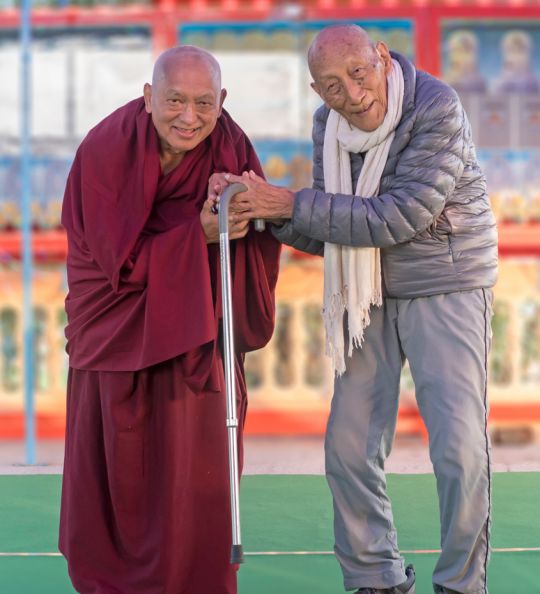
Lama Zopa Rinpoche with Khyongla Rato Rinpoche at Root Institute, Bodhgaya, India, January 2018. Photo by Ven. Lobsang Sherab.
Keep up with Lama Zopa Rinpoche on his travels throughout the world by viewing new photo albums of Rinpoche’s journeys. The new photo album of Rinpoche’s recent trip to India contains sixty photos, covering Rinpoche’s time at Root Institute in Bodhgaya and in Tso Pema:
https://fpmt.org/teachers/zopa/gallery/india-january-2018/
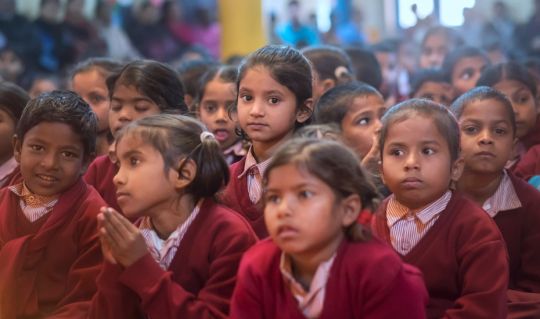
Students at Maitreya School during a visit by Lama Zopa Rinpoche, Bodhgaya, India, January 2018. Photo by Ven. Lobsang Sherab.
More photos from Rinpoche’s December visit to Nepal, to India in November, and to Italy, Austria, and the United States earlier in the year, plus many more, can be found on Lama Zopa Rinpoche’s photo gallery page:
https://fpmt.org/teachers/zopa/gallery/
The photo gallery display has been updated to optimize viewing on mobile phones and tablets. New features have been added; click or tap on photos to see captions and enter slideshow mode.
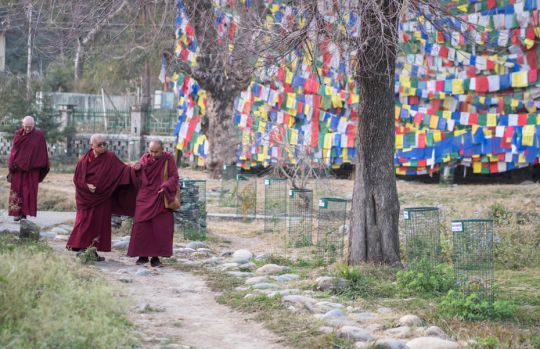
Lama Zopa Rinpoche circumambulating the lake at Tso Pema, India, January 2018. Photo by Ven. Lobsang Sherab.
More information, photos and updates about FPMT spiritual director Lama Zopa Rinpoche can be found on Rinpoche’s webpage on FPMT.org. If you’d like to receive news of Lama Zopa Rinpoche and FPMT via email, sign up to FPMT News.
- Tagged: lama zopa rinpoche, photo gallery
- Home
- News/Media
- Study & Practice
- About FPMT Education Services
- Latest News
- Programs
- New to Buddhism?
- Buddhist Mind Science: Activating Your Potential
- Heart Advice for Death and Dying
- Discovering Buddhism
- Living in the Path
- Exploring Buddhism
- FPMT Basic Program
- FPMT Masters Program
- FPMT In-Depth Meditation Training
- Maitripa College
- Lotsawa Rinchen Zangpo Translator Program
- Universal Education for Compassion & Wisdom
- Online Learning Center
- Prayers & Practice Materials
- Overview of Prayers & Practices
- Full Catalogue of Prayers & Practice Materials
- Explore Popular Topics
- Benefiting Animals
- Chenrezig Resources
- Death & Dying Resources
- Lama Chopa (Guru Puja)
- Lama Zopa Rinpoche: Compendium of Precious Instructions
- Lama Zopa Rinpoche: Life Practice Advice
- Lama Zopa Rinpoche Practice Series
- Lamrim Resources
- Mantras
- Prayer Book Updates
- Purification Practices
- Sutras
- Thought Transformation (Lojong)
- Audio Materials
- Dharma Dates – Tibetan Calendar
- Translation Services
- Publishing Services
- Teachings and Advice
- Find Teachings and Advice
- Lama Zopa Rinpoche Advice Page
- Lama Zopa Rinpoche: Compendium of Precious Instructions
- Lama Zopa Rinpoche Video Teachings
- ༧སྐྱབས་རྗེ་བཟོད་པ་རིན་པོ་ཆེ་མཆོག་ནས་སྩལ་བའི་བཀའ་སློབ་བརྙན་འཕྲིན།
- Podcasts
- Lama Yeshe Wisdom Archive
- Buddhism FAQ
- Dharma for Young People
- Resources on Holy Objects
- Ways to Offer Support
- Centers
- Affiliates Area
- Teachers
- Projects
- Charitable Projects
- Make a Donation
- Applying for Grants
- News about Projects
- Other Projects within FPMT
- Support International Office
- Projects Photo Galleries
- Give Where Most Needed
- FPMT
- Shop
Translate*
*powered by Google TranslateTranslation of pages on fpmt.org is performed by Google Translate, a third party service which FPMT has no control over. The service provides automated computer translations that are only an approximation of the websites' original content. The translations should not be considered exact and only used as a rough guide.Think that everyone you meet is fulfilling all your wishes.







